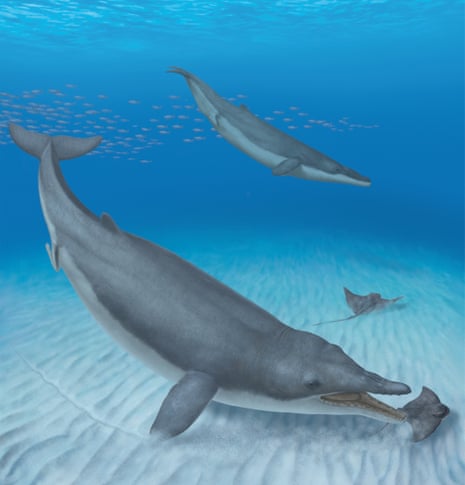Fossil hunters say they have unearthed a missing link in the evolution of baleen whales after digging up the remains of a creature thought to have lived more than 36 million years ago.
The whales, known as mysticeti, sport a bristling collection of sieve-like plates known as baleen that they use to filter water for food. Species include the enormous blue whale, the gray whale and the humpback whale.
But while baleen whales are known to have shared a common ancestor with toothed whales, which are the other major group of modern whales, the path by which the creatures emerged has been somewhat hazily understood. Now researchers say they have discovered the oldest known cousin of modern baleen whales, offering unprecedented insights into their evolution.
“This [split in the family tree] has been dated to about 38 or 39m years ago,” said Olivier Lambert, co-author of the research from the Royal Belgian Institute of Natural Sciences. “The whale we discovered here has been dated to 36.4 [million years ago], so it is only two to three million years younger than this presumed origin.”
Unearthed at a site known as Playa Media Luna on the southern coast of Peru, the newly discovered creature has been named Mystacodon selenensis – a portmanteau of the Greek for “moustache” and “tooth”, together with a nod to the Greek goddess of the moon.
The animal would have been just under four metres in length but, rather than boasting baleen, it had a mouthful of teeth and apparently vestigial hind limbs.
From an analysis of the skull, jaw and teeth, Lambert says that the newly unearthed animal likely hoovered up other marine creatures by suction feeding, moving its tongue to lower the pressure inside its mouth and draw its prey in, before expelling the water.
“If it was indeed using suction to catch its prey, it means that the prey items could not be too large, because the whole animal was swallowed in a single gulp – so medium sized fish, maybe small squid, could have been a good type of prey for such an animal,” he said.
By contrast, the ancestors of both baleen and toothed whales are thought to have captured prey by grabbing it with their teeth, a method also used by many modern toothed whales.
The feeding method and body form of the new creature, added Lambert, backs up previous predictions of the features expected for an animal near the bottom of the baleen branch of the whale family tree.
“Sometimes it is good to see that predictions were precise enough, and well documented, in a way that new fossils really fit the story,” he said.
What’s more, said Lambert, the find ties in well with the recent discovery of “Alfred”, a much younger, toothed fossil whale dating from 25m years ago that is also thought to have been a suction feeder and falls on the baleen branch of the whale family tree.
But the new find has also thrown up surprises, not least that the creature was found to have tiny, probably useless, hind limbs sticking out from its body. That, says Lambert, was a shock.
The absence of hind limbs in all modern whales, together with evidence of apparently vestigial limbs in fossils dating to before the split in the whale family tree, had previously led scientists to believe the appendages had been lost in a common ancestor of toothed and baleen whales.
But the new finding, published in the journal Current Biology, suggests that both branches of the whale family tree lost the hind limbs independently.
Emily Rayfield, professor of palaeobiology at the University of Bristol who was not involved in the research, welcomed the findings, adding that the suggestion that the creature was a suction feeder ties into recent theories about how terrestrial animals returned to the water and evolved into the whales we see today.
“I think it is an interesting new fossil from an exciting part of the world that shows how new information can enrich and development our understanding of the evolution of groups, including their feeding strategies,” she said.

Comments (…)
Sign in or create your Guardian account to join the discussion